Category: Candidate Attraction
Digital Sourcing Strategy and Centralization Reduced Time-to-Hire by 20%

Situation
A leading retailer engaged with PeopleScout to improve their application process. Despite having a well-known and well-loved consumer brand, the retailer relied on job boards to bring in candidates. The client’s application took 30 minutes to complete, and could not be completed on a mobile device, alienating or inconveniencing many job candidates.
The client knew it was losing a large portion of applicants because of its cumbersome application process. To apply, candidates needed access to a computer to fill out a 30-question application that took half an hour to complete—even for part-time positions.
The client engaged with PeopleScout, looking for a partner with technology and candidate experience expertise to remake the entire recruitment process in order to place the candidate at the center.
Solution
Expanded Sourcing Strategy
PeopleScout worked with the client to carefully craft an expanded sourcing strategy, including targeted digital recruitment marketing centered on attracting, engaging and converting candidates in online spaces. The strategy was focused on people who have an affinity for the client’s brand but may not be actively looking on job boards. Then, PeopleScout was able to drive those candidates to a quick, easy mobile apply process.
Mobile-first Apply
PeopleScout developed a mobile-first application designed to work easily through a smartphone and reduce candidate fall out. The new application is completed by all candidates, regardless of role.
Shortened Application
The new application includes just 11 questions on one page and takes less than eight minutes to complete. The client worked with PeopleScout to reduce the amount of information asked from candidates during the application stage in order to streamline the process.
Results
Half of Candidates Now Apply on Mobile
Nearly two-thirds (65.9%) of all candidates applying to this client now apply through a mobile device. Before working with PeopleScout, the client was excluding or at the very least inconveniencing a large portion of its talent pipeline.
Application Time Reduced From 30 Minutes to Less Than Eight
Applicants can consistently complete the application in eight minutes or less, with some candidates able to complete it in as little as six minutes.
Application Conversion Rate
The application conversion rate rose to 85% with the new shortened mobile application process. The rate for a traditional application is around 35%.
Broadened Talent Pipeline, Improved Candidate Quality and Shortened Time to Hire
The client no longer relies solely on job boards to build their pipeline and relies on a variety of sourcing strategies. This led to hiring of quality candidates, improving the slate-to-hire to one candidate hired for every 1.3 presented and shortened time-to-hire by more than 20%.
At a Glance
- COMPANY
Leading retailer - PEOPLESCOUT SOLUTIONS
Recruitment Process Outsourcing, Affinix - ANNUAL HIRES
6,800
AI Candidate Sourcing: How AI Is Transforming Talent Discovery
With today’s skills shortages, recruiters are facing a more and more daunting challenge of identifying and engaging qualified candidates efficiently. Artificial intelligence (AI) has emerged as a game-changing technology in the recruitment process, particularly in talent sourcing. AI candidate sourcing represents a significant advancement, helping organizations go from manual database searches, job board postings and referral networks to fast, automated processes.
According to a survey by Workable, 63% of organizations now use some form of AI in recruiting. But only 8% use AI for candidate sourcing. By thoughtfully integrating AI into sourcing strategies, talent acquisition teams can spend less time searching for candidates and more time building meaningful connections.
This article explores how AI sourcing tools are transforming recruitment strategies and offers practical insights for organizations looking to enhance their talent acquisition efforts.
The Evolution of AI Candidate Sourcing
The digital transformation of recruitment began with the advent of applicant tracking systems and online job boards, but AI has taken sourcing capabilities to unprecedented levels. AI excels at scale. By analyzing a massive data set of millions of pieces of information including online candidate profiles, AI can identify candidates within minutes. For example, Affinix®, PeopleScout’s proprietary total talent suite of AI-powered tools, accesses over 1.3 billion public profiles of passive candidates across 23 of the top global job sites within seconds of a requisition opening.
Key Capabilities of AI Candidate Sourcing
AI sourcing has revolutionized talent discovery, empowering organizations to identify, assess and engage talent with remarkable precision and efficiency. Here a few of the benefits of AI sourcing tools.
1. Advanced Candidate Matching
AI algorithms excel at pattern recognition and can analyze vast datasets to identify candidates whose skills, experience and potential align with job requirements, including passive candidates who may not be actively job searching but have the right qualifications. These individuals rarely respond to traditional job postings, making them invisible to conventional recruitment methods. AI candidate sourcing excels at identifying hidden gems based on their digital footprints and professional activities, enabling recruiters to engage with talent that would otherwise remain undiscovered.
Unlike traditional keyword matching, modern AI sourcing tools leverage skills matching with sophisticated natural language processing and machine learning algorithms to comprehensively analyze candidate profiles. By understanding semantic relationships between skills, experiences, and job requirements, leading technologies can create nuanced candidate rankings, allowing recruiters to rapidly filter through candidates and automatically generating a prioritized shortlist of top talent that precisely matches the role’s requirements. Recruiters can now focus their valuable time on engaging with the most promising candidates, rather than getting bogged down in manual screening processes.
2. Expanded Talent Pool Access
AI candidate sourcing dramatically expands recruiter reach by continuously scanning multiple sources simultaneously, creating a comprehensive talent mapping solution that would be impossible to achieve manually. Professional networking sites like LinkedIn represent just the beginning. AI sourcing extends to portfolio platforms like Behance and Dribbble for creative roles, GitHub repositories for technical talent, specialized industry forums where experts engage, academic publications that showcase research credentials, and even carefully analyzed social media profiles that reveal professional interests and accomplishments. In addition to external candidate profiles, Affinix also searches your existing talent database to support direct sourcing, internal mobility and redeployment.
AI sourcing tools look at qualifications and experiences across industries, opening doors to talent that might otherwise be missed. For example, AI sourcing might identify that project management experience in healthcare could translate effectively to similar roles in education or technology, despite the different industry contexts. This cross-industry perspective is particularly valuable in today’s market where career pivots are increasingly common, and skills transferability is highly valued.
3. Reduced Bias with AI Candidate Sourcing
AI tools can help mitigate unconscious bias in sourcing by helping you create objective evaluation frameworks that focus on skills and qualifications, regardless of demographics. By emphasizing capabilities and potential over education, pedigree, or other factors that can trigger unconscious bias in humans, these systems help create a more equitable initial candidate pool.
By ensuring that every potential hire is assessed against the same objective benchmarks and that hiring managers review qualified candidates from varied backgrounds, AI sourcing tools widens the lens through which talent is viewed, helping companies build more diverse and innovative teams while reducing adverse impact.
Ethics & Bias Prevention in AI Candidate Sourcing
Continuous bias detection and mitigation have become fundamental to implementing AI sourcing tools to neutralize potential discrimination in candidate selection. TA teams must collaborate with legal and IT teams to conduct detailed examinations of candidate recommendations and conduct regular audits. Cross-functional collaboration will help organizations navigate the complex legal landscape of AI for recruiting while creating more objective, inclusive talent acquisition strategies.
How AI Candidate Sourcing is Impacting Recruiters
The advent of AI sourcing tools has fundamentally reshaped the recruiter’s role, shifting their focus from administrative task management to high-value activities. Where recruiters once spent countless hours manually searching and screening résumés and CVs, AI now handles these time-consuming processes, elevating the recruiter’s role to that of a strategic talent advisor. Recruiters now invest their energy in complex negotiation, relationship building and deep candidate engagement.
AI Candidate Sourcing & RPO
Recruitment process outsourcing (RPO) providers are at the forefront of leveraging advanced AI sourcing technologies. By leveraging AI candidate sourcing through our proprietary tech suite, Affinix, PeopleScout can process vast amounts of candidate data, identify top talent, and create highly targeted talent pools that would be impossible to develop through traditional recruiting methods. Affinix has a proven track record of dramatically reducing time-to-hire and creating cost savings for our clients. As organizations continue to face complex talent challenges in a rapidly evolving global marketplace, AI-powered RPO solutions represent a critical strategic approach to building agile, competitive workforces that can adapt to emerging business needs.
Apprenticeship Recruitment in the UK: The Key to Future-Proofing Your Talent Pipeline?
Apprenticeship recruitment has taken on more importance in early careers programs in recent years. According to UK Government data, the most recent academic year saw a 7% increase in apprenticeship starts and 10% increase in apprenticeship achievements. Organizations and employees alike are waking up to the fact that many skills can be learned on the job—and that it’s often more relevant training than a university degree.
Whether for workers just starting out or those changing careers, apprenticeships help people gain valuable skills and on-the-job experience as they move toward a career in their field. For employers, field and business apprenticeships are one of the best ways of engaging early careers talent or career changers. Whilst providing opportunities for hands-on experience and training, apprenticeships help businesses to develop a talent pipeline that is equipped with future-ready skills.
In this article, we’ll explore how designing and offering apprenticeship programs can be a smart way for organizations to create their own talent pipeline, close their skills gaps and diversify their workforce.
What is an Apprenticeship?
An apprenticeship is paid employment that offers on-the-job training and is often accompanied by classroom-based learning. Some employers may offer their own in-house training while others offer it in association with a college, university or other training provider. An apprenticeship must last at least a year but can go as long as 5 years. Through in-depth, job- and industry-specific skills training, apprentices gain a nationally recognized qualification or certification upon completion.
Apprenticeship programs are a great choice for individuals who are early on in their careers, who are looking to upskill or who are exploring a career change. Employers are responsible for ensuring that apprentices work with experienced staff, learn job-specific skills and receive time off from work to complete their classroom training.
Different countries have different laws and regulations around apprenticeships including wages and working hours. There are also various funding programs and government schemes available to encourage both workers and employers to embrace apprenticeships. For example, the UK Government introduced the (controversial) apprenticeship levy in 2017 which uses business taxes to fund apprenticeship training.
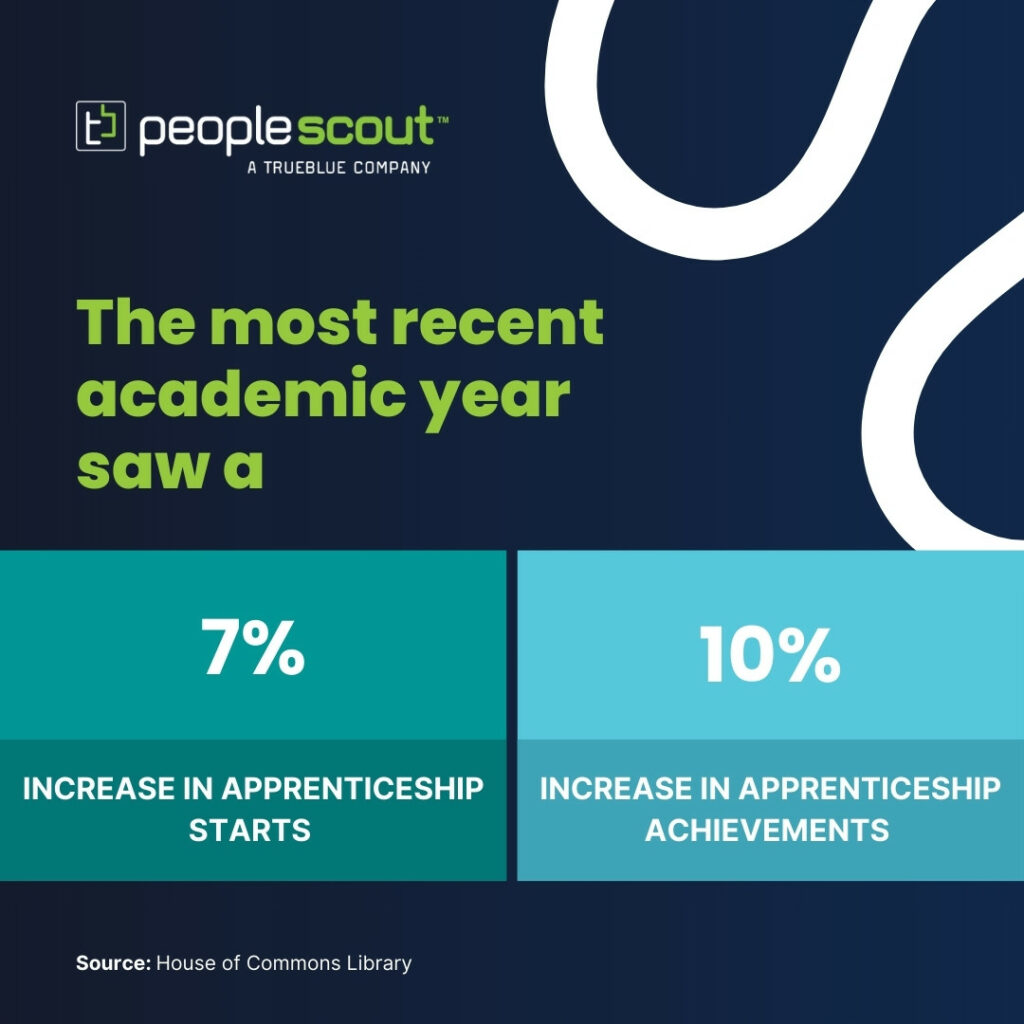
Types of Apprenticeships
A common misperception is that apprenticeships are just for manual or skilled trade jobs. Whilst there are many apprenticeship programs in the skilled trades, there are also apprenticeship opportunities for all kinds of careers from actuaries to arborists. For example, our client, National Highways, offers apprenticeship opportunities for project management, business administration, legal, surveying and data analysis. Organizations are increasingly embracing corporate apprenticeships and traineeships as a means of diversifying their workforce and creating opportunities for social mobility.
There are different levels of apprenticeship including degree apprenticeships which correspond to an equivalent education level. Completing a Level 2 apprenticeship is the equivalent of completing a GCSE, and a Level 7 apprenticeship is the equivalent of completing a master’s degree.
Benefits of Apprenticeship Recruitment for Employers
Apprenticeship recruitment can be an effective way of growing and upskilling your workforce. Here are just a few of the benefits for employers.
Building a Talent Pipeline
Companies in a variety of industries can build their own apprenticeship programs to help talent see the rewarding career opportunities available within their sector. As apprentices gain experience, organizations establish a pipeline of prospective employees.
Early careers employees see apprenticeship programs as proof of an organization’s investment in their success and are more likely to stay with an organization after completing the program. In fact, 80% of apprentice employers say they have seen a significant increase in employee retention. Clearly, apprenticeship recruitment is an excellent way to “grow your own talent” and reduce attrition.
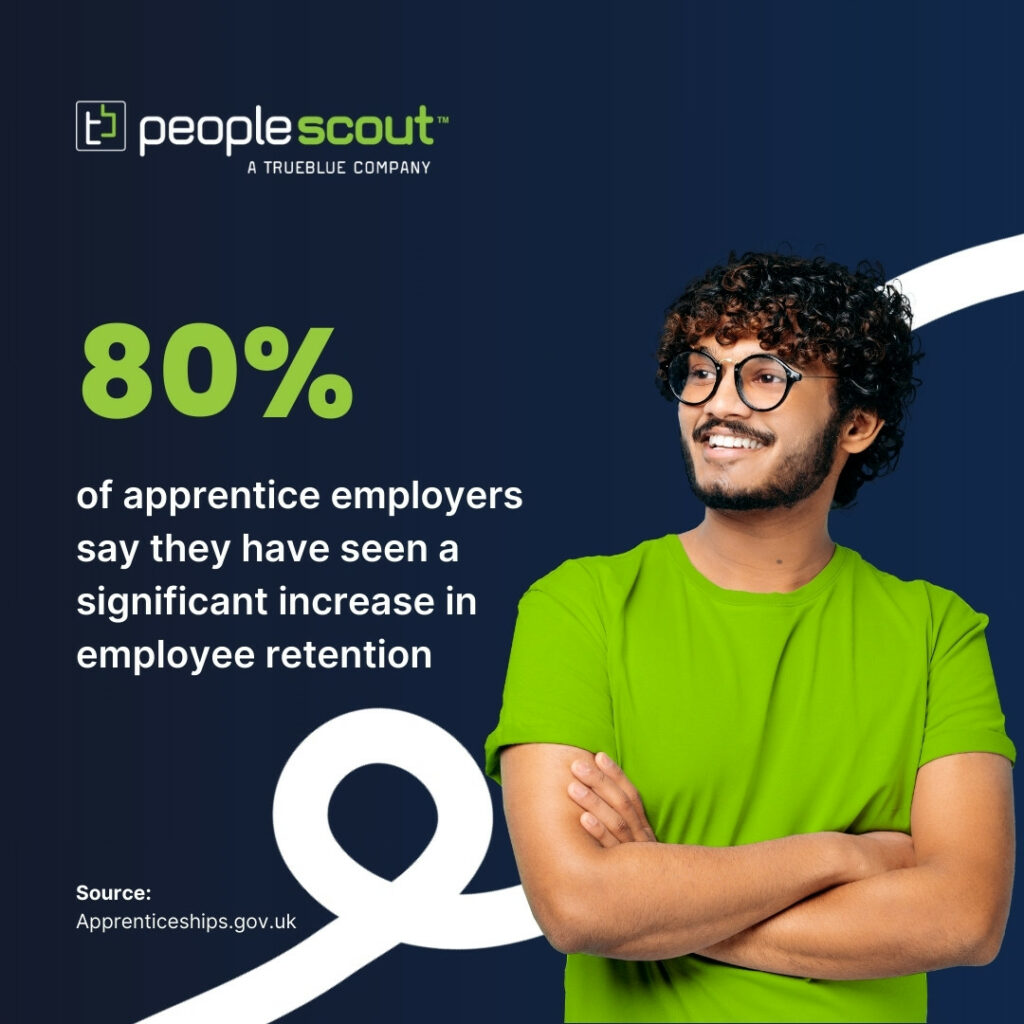
Closing Skills Gaps
According to McKinsey, a whopping 87% of organizations are aware they already have a skills gap within their workforce or will experience one in the next few years. Apprenticeships offer a way to develop a new generation of workers to help your organization succeed into the future. A structured apprenticeship is an effective way to get a leg up in recruiting and retaining sought-after talent like software developers, data analysts and engineers. Indeed, 86% of employers said that investing in apprentices helped to develop relevant skills for the organization.
The digital skills gaps alone could cause 14 G20 countries to miss out on a staggering $11.5 trillion USD in cumulative GDP growth. In the UK, companies like Dyson are partnering with the University of Warwick to offer apprenticeship training in engineering, data science and machine learning.
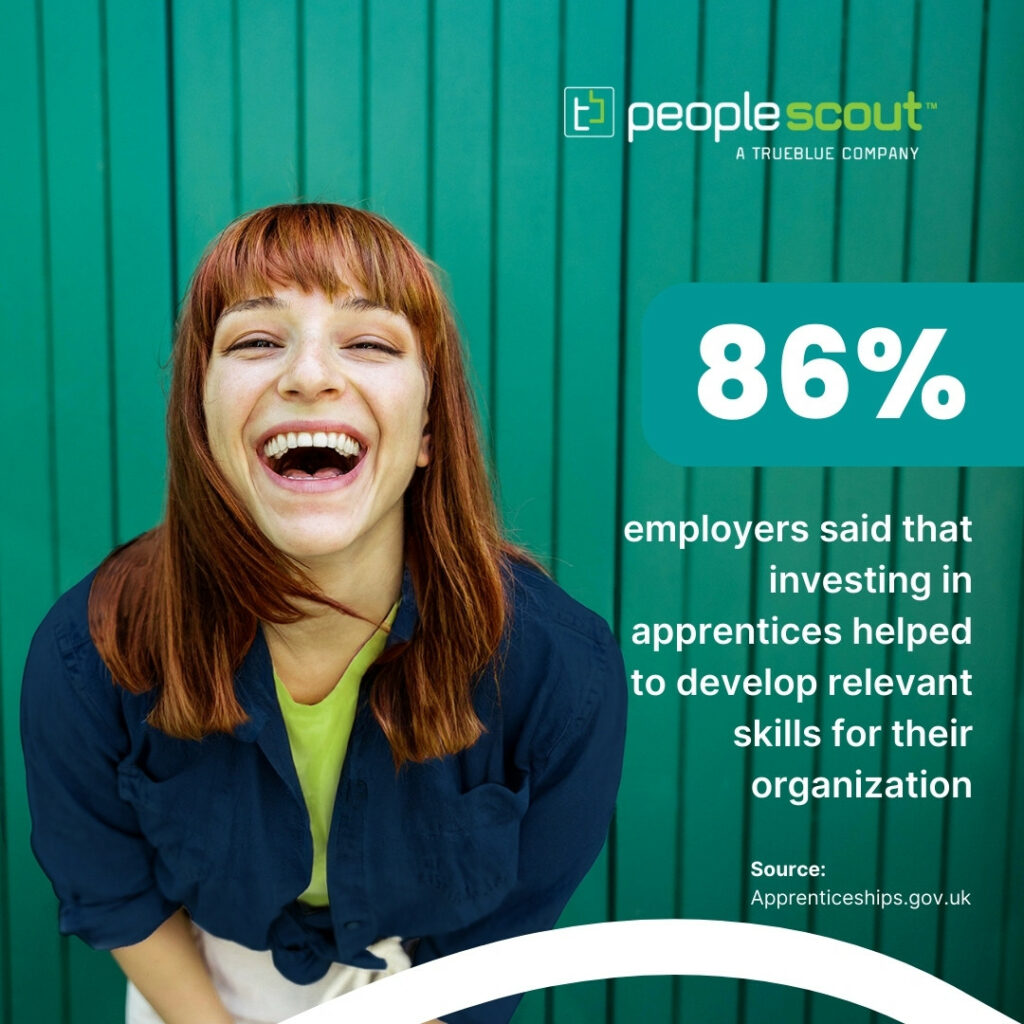
Boosting Diversity & Social Mobility
A third of employers agree that apprenticeships have helped improve diversity within their business. They are particularly effective for creating career opportunities and boosting earnings for workers from disadvantaged socio-economic backgrounds.
As more people struggle financially with student loans and education costs, apprenticeships have become an accessible career path for workers of all ages and backgrounds and give participants a shot at career success. They allow workers from underrepresented groups to increase their earnings potential—to work and earn money in the field while they learn. If your company cares about being a catalyst for sustained change in the community, apprenticeships are a great way to achieve this.
RPO + Apprenticeship Recruitment
As a leading recruitment process outsourcing (RPO) provider, PeopleScout helps organizations to obtain the talent and skills they need to succeed into the future through early careers recruitment solutions covering interns, graduates and apprenticeship programs. Unlike apprenticeship recruitment agencies, as an RPO partner, our expertise in talent acquisition strategy and workforce planning means we’re better equipped to successfully integrate apprentice programs into your overall talent attraction and training strategy. Plus, we have experts on staff that can design an assessment center that evaluates apprentice candidates against your organization’s values, culture and other requirements.
Professional Search: Sourcing a Transformative Leader to Boost Diversity in Schools

Situation
When the Office for Standards in Education, Children’s Services and Skills (Ofsted), the regulator for services for children and young people in England, revealed they would be implementing changes to their framework, our client, a local government agency in the UK, knew that the Director of Education and Skills position, which had been put on hold and filled by interim leaders for several years, needed to become a top priority.
The agency recognized there was a lack of teacher diversity which didn’t reflect the community. Plus, although progress had been made, there was still a need to focus on special educational needs and disabilities (SEND). On top of these challenges, Good and Outstanding ratings from Ofsted had dropped.
To counter this, they were looking for a new director with SEND experience who could build relationships with education leaders to get the best out of the area’s diverse schools–putting social justice at the heart of the community while maintaining achievement and attainment.
The agency turned to PeopleScout for our Apex senior professional hiring solution.
Solution
The PeopleScout Apex team took an extensive brief from the Executive Director, benchmarked profiles to further refine our search and presented a target list of people to approach which the client approved. Alongside this outreach, PeopleScout processed all candidates generated through advertising using the same method as the proactively sourced candidates to ensure a fair and open process.
PeopleScout performed a first round of interviews, presenting the qualifying candidates to the client for consideration with a written report for each. We partnered with the client in the technical interview, providing comprehensive feedback and recommendations to inform the final shortlisting process. A PeopleScout Apex team member was also present at the final interviews to provide advice and guidance.
Results
Altogether, we identified and reached out to 59 potential candidates. Out of these 54 people engaged, resulting in a 92% engagement rate. Nine candidates were selected for the first stage of interviews with three proceeding to the final round. Ultimately, one hire was made.
- 59 candidates identified
- 54 engaged
- 9 interviewed at first stage
- 3 interviewed at second stage
“Thanks very much for all the support from PeopleScout for the recent recruitment of our Director of Education and Skills. We have been impressed with the quantity and caliber of candidates—which has been recognized by the selection committee. Thanks for an overall professional service.”
Head of Internal Communications & Organizational Development
Neurodiverse Recruitment: 6 Ways to Make Your Hiring Process More Neuro-Inclusive
Neurodiverse recruitment unlocks a wealth of unique strengths, offering employers access to exceptional skills in pattern recognition, analysis, mathematics and beyond. This approach to hiring isn’t just inclusive—it’s a catalyst for innovation. By building cognitively diverse teams that blend neurodivergent and neurotypical talent, organizations supercharge their creativity, decision-making and problem-solving capabilities. The result? A dynamic workforce that drives efficiency and innovation to new heights.
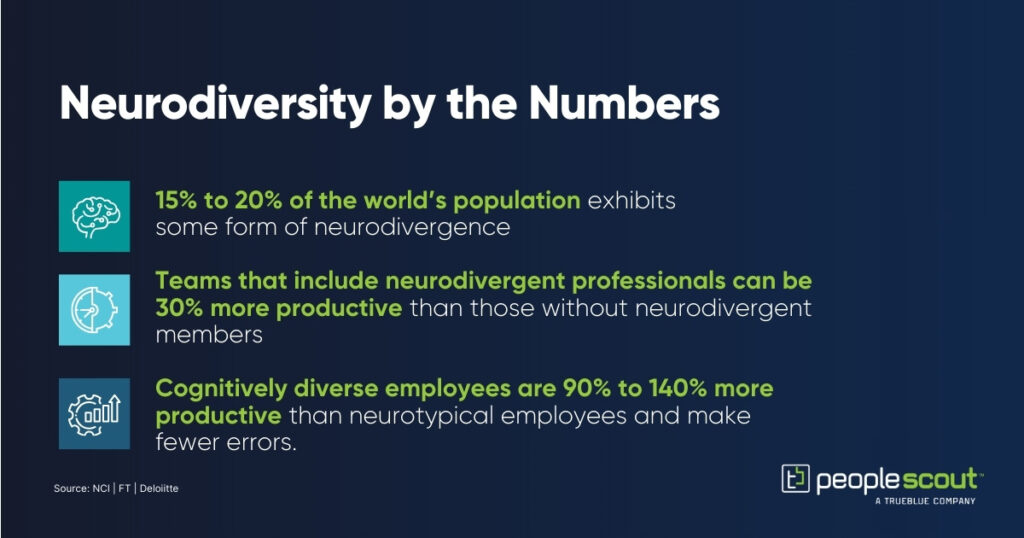
The untapped potential of neurodivergent talent is staggering, with alarming underemployment rates that rob both candidates and companies of incredible opportunities. In the U.S., it is estimated that as many as 85% of college-educated autistic adults struggle with unemployment. The Office for National Statistics (ONS) paints an equally grim picture for the UK, with just 21.7% of autistic individuals employed. In Australia, 70% of new starters with disabilities do not survive the probation period, while 65% of Australian businesses remain unsure about how to access this rich talent pool.
While many organizations aspire to build a workforce that harnesses the potential of the neurodivergent community, few achieve this goal. While the reasons behind this gap are multifaceted, there’s a critical knowledge gap about neurodiversity in the workplace and how to create neuro-inclusive hiring processes.
Ready to move the needle on neurodiverse recruitment? Let’s dive into five strategies that will transform your hiring process and unlock the full potential of neurodivergent talent.
What is Neurodiversity?
First, let’s define what we mean by neurodiversity. Neurodiversity refers to the concept that everyone experiences and interacts with the world around them differently. A neurodivergent person’s brain may work in a different way than the average “neurotypical” person. They may have unique ways of learning, communicating, working, socializing or perceiving their surroundings.
While neurodiversity is often used in the context of autism spectrum disorder (ASD) and Asperger’s syndrome, many conditions fall under the neurodivergent umbrella, including ADHD, dyslexia, dyspraxia, Down syndrome, Tourette syndrome, and even mental health conditions like bipolar disorder, OCD and social anxiety.
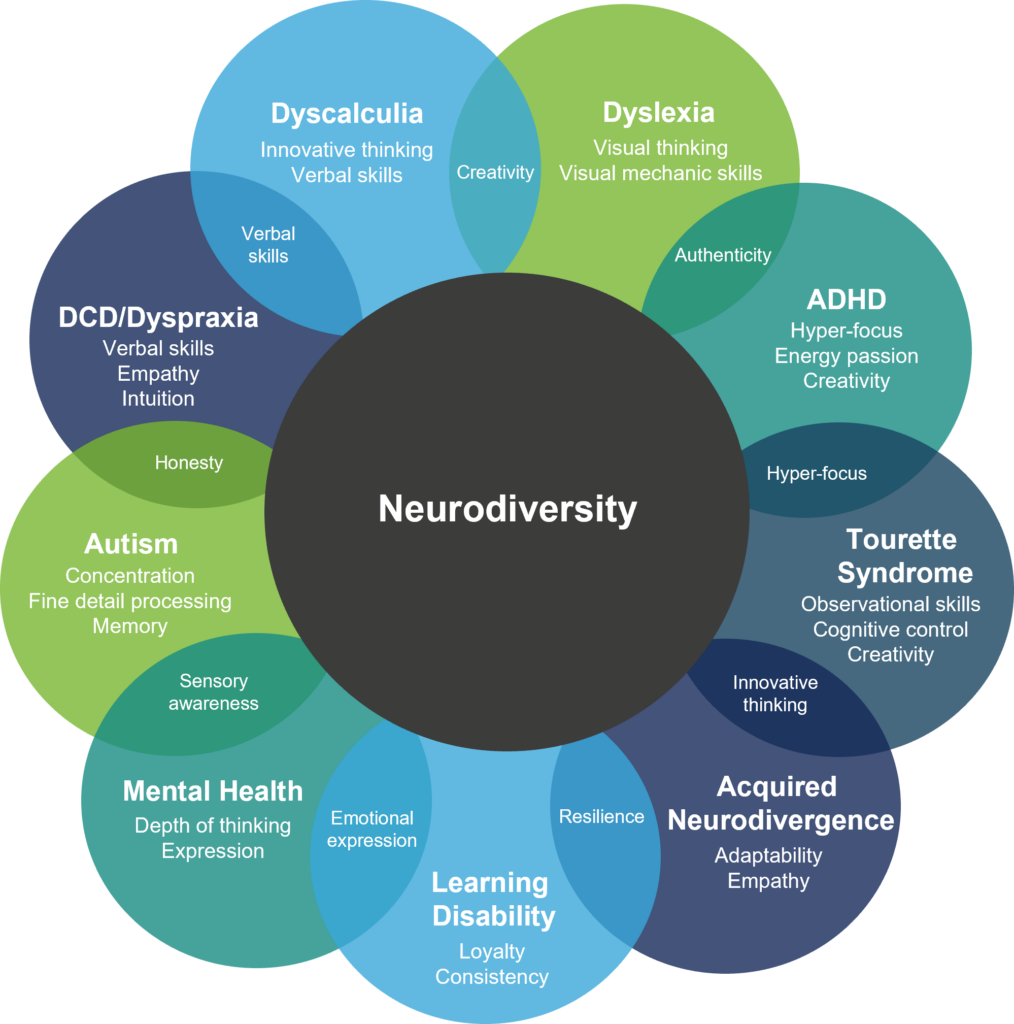
6 Strategies for Neurodiverse Recruitment
There’s no one-size-fits-all solution for neuro-inclusive recruitment, as neurodiversity encompasses a wide range of conditions, many of which may be undiagnosed or undisclosed. The key is to create a flexible process that can be tailored to individual needs.
1. Identify Roles for Neurodivergent Recruitment
To identify roles for neurodivergent talent, companies need to think beyond traditional job categories and focus on the core skills and tasks involved. Analyze and pinpoint positions that require deep focus, pattern recognition or systematic thinking—areas where many neurodivergent individuals excel. Look for roles that benefit from attention to detail, data analysis, quality control or creative problem-solving.
Tech roles often offer a goldmine of opportunities, from software development to cybersecurity. But don’t limit yourself—neurodivergent talent can thrive in unexpected places. Consider positions in finance, research, design or even customer service roles that involve script-based interactions.
You might also consider job carving, which involves customizing job roles by reorganizing tasks to create a new, tailored position that aligns with an individual’s strengths and abilities. This approach not only benefits neurodiverse employees by providing them with roles tailored to their abilities but also helps organizations make the most of their diverse workforce.
The key is to break down jobs into their fundamental components and match them with the unique strengths often associated with neurodiversity. Remember, it’s about recognizing where neurodivergent traits can be a significant asset to your existing needs.
2. Audit the Application Process for Neurodivergent Recruitment
Once you’ve identified roles where neurodiverse talent can thrive, it’s time to audit the application process. Put on your detective hat and scrutinize every step. Is it neurodiversity-friendly, or is it secretly working against you?
First start with the job description. Consider replacing lengthy, jargon-filled job descriptions with clear, concise summaries of the core responsibilities. Embrace inclusive language that speaks to diverse cognitive styles. Think less “excellent multitasker” and more “deep focus on specialized tasks.”
Then, move onto the application itself. Complex, multi-step applications can overwhelm candidates with conditions like ADHD or autism, potentially causing them to abandon the process altogether. Simplify application forms by asking only for essential information. You could even consider offering alternative submission methods, like video applications.
Ditch the requirement for cover letters in favor of skill-based assessments that directly relate to the job. By streamlining the application step, you level the playing field and tap into a rich pool of often-overlooked talent.
3. Communicate Early & Often
Be direct with your language and deliver information in multiple ways. Some candidates will be okay with written instructions, others like those with dyslexia, may receive information better through videos or audio explanations.
Start by providing a clear preview of the entire recruitment journey. Communicate each stage, what the candidate will be required to do and how they’re being evaluated. This transparency benefits all candidates but is particularly crucial for neurodivergent individuals who may need to prepare mentally for each phase.
Maintain frequent, personalized communication throughout the process. Strategic follow-ups can keep candidates engaged and comfortable, increasing the likelihood of offer acceptance. This ongoing dialogue also provides opportunities for candidates to ask questions or request additional accommodations as needed.
4. Balance Assessments & Interviews
Making the interview and assessment steps more neuro-inclusive is crucial for tapping into the diverse talent pool of neurodivergent candidates. While interviews shouldn’t be eliminated entirely, consider balancing them with other evaluation methods.
Shift the focus from traditional metrics to a strength-based evaluation approach. Look for candidates’ unique capabilities and how they align with job requirements, rather than adhering strictly to conventional interview performance criteria. For candidates requiring adjustments, you might weigh interviews less heavily in your overall evaluation, focusing more on practical skill demonstrations or work samples.
When it comes to assessments, large, complex exercises can be overwhelming for some neurodivergent candidates. Break these down into smaller tasks and add in the option to take breaks. Additionally, consider offering extra time for assessments if needed, focusing on the quality of work rather than speed of completion.
A blended assessment approach that incorporates multiple question styles and task types is great option for assessing neurodivergent talent. For instance, at Heathrow we introduced a completely bespoke virtual testing platform called One Experience Assessment (1XP) to recruit for their security officer roles. This included visual “spot the difference” exercises alongside traditional questions, providing a realistic job preview while allowing candidates to demonstrate their skills in different ways.
5. Be Prepared to Provide Accommodations & Adjustments for Neurodiverse Recruitment
Organizations should proactively prepare to provide reasonable adjustments and accommodations for neurodiverse candidates during the recruitment process. Flexibility should be a cornerstone of your approach as everyone has unique needs.
Be prepared to offer extra time for assessments, adjusting standard time limits or breaking longer tasks into manageable chunks. Additionally, be open to changing the location or format of interviews or allowing the use of assistive technology like screen readers during online assessments. Provide interview questions in advance to make the experience more accessible for those who process information differently.
Neurodiverse candidates may experience “sensory overload” in office environments and during in-person interactions. To help candidates better focus on demonstrating their skills and qualifications, design interview spaces with adjustable lighting, offer noise-canceling headphones and provide multiple seating options. These seemingly small adjustments can significantly reduce sensory sensitivity and anxiety.
6. Customize Onboarding & Beyond
Creating effective onboarding programs for neurodiverse employees is crucial for integration into the workplace and their long-term success. Recognize that each neurodivergent employee may have different needs and preferences, and be prepared to tailor the onboarding experience accordingly.
Training is a cornerstone of successful integration. This should be a two-way street, involving both the neurodiverse employee and their colleagues. Provide education and diversity training to managers and team members in advance of or early in the onboarding process. These sessions should sensitively address the characteristics and preferences of neurodivergent individuals, always respecting privacy and dignity. For instance, explain that a colleague with autism might avoid eye contact, helping coworkers understand this isn’t a sign of disinterest. Similarly, managers should be trained on how to introduce neurodiverse team members appropriately, avoiding potentially uncomfortable situations like introductions in large group settings.
Once neurodiverse employees start work, any adjustments offered during recruitment should be available in the workplace as well, ensuring a seamless transition from candidate to employee. By anticipating and preparing for these accommodations, organizations create an environment where neurodiverse candidates can thrive. This may also require implementing flexible working patterns that play to individual strengths. Offering adjustable work hours, remote work options or customized workspaces can help minimize sensory overwhelm.
To further support neurodiverse employees, consider developing growth opportunities tailored to the unique needs of neurodivergent employees. This could include specialized mentorship programs or coaching sessions that focus on leveraging their strengths and navigating workplace challenges. By implementing these strategies, companies can create an onboarding experience that not only welcomes neurodiverse talent but sets them up for long-term success and growth within the organization.
The Importance of Neurodivergent Recruitment
Embracing neurodiverse recruitment is not only a step towards inclusivity but a strategic move that leverages the unique strengths of this group to foster innovation and enhance performance. By closing the knowledge gap and implementing targeted strategies, organizations can create a more inclusive work environment that truly maximizes the potential of all employees, leading to a more dynamic and productive workforce.
Social Value in Action: Flight for the Community
By Thomas Mason-Paley, Bid Director
‘Is there a social value question? What’s the weighting?’ In my role as Bid Director, I come across this in almost every pitch invitation.
For the uninitiated, almost all formal tenders now ask what a bidder will do, over and above the contract, to help support local communities, disadvantaged groups or the population at large.
To be honest, it gives me mixed feelings. In theory, it is important that businesses give back in meaningful ways, especially those receiving money from the public purse. Through collective efforts, combining the reach of the public sector with the skills of the private sector, we can significantly improve lives, and in turn, make society safer, richer and better for all.
However, I also understand the hurdles; not every company has the resources to make a real impact. For example, does an SME business, with few staff, really possess the time, money and resources to run employability workshops or CV writing webinars? When a client asks for time, resources and money from a provider, it runs the risk of social value becoming a ‘necessary evil’ which delivers poor returns for all, rather than a genuine force for good.
“Effective philanthropy requires a lot of time and creativity – the same kind of focus and skills that building a business required.”
– Bill Gates
It’s easy to complain and point out challenges. Anyone can do that; finding solutions is much harder. I believe PeopleScout and Heathrow Employment and Skills Academy provide a great example of combining resources, applying creativity and utilising key skills to deliver social good that benefits all.
The two organisations work in genuine collaboration to help Heathrow’s wider community find meaningful and gainful employment across the whole of the Airport, from shops and restaurants through to engineering and mechanical departments.
Heathrow, and its business partners, advertise available roles via the Heathrow Employment and Skills Academy website. PeopleScout screens candidates to ensure suitability and provide more insight into specific roles to ensure candidates fully understand responsibilities and would be comfortable working within the environment. We then book interviews on their behalf. Just as importantly, PeopleScout provides these candidates with advice and guidance prior to interviews, ensuring they are ready, motivated and equipped to increase their chance to succeed in the recruitment process. This personal and supportive service is most important for people who have been out of work for a long time or who may be making their first ever application for paid employment.
We also work with the Heathrow Employment and Skills Academy to deliver careers and essential skills workshops, employment webinars and community drop-in sessions. These are not projects which are ‘outsourced’ to PeopleScout, they are truly collaborative events that enable us to support the local community, with shared resources and shared goals, utilising the skills of both PeopleScout and Heathrow teams to maximum effect.
We have also re-written advertising content to ensure it is fully inclusive and appeals to different demographics, thereby ensuring no group feels hesitant about applying for roles that could significantly improve their lives.
This combined approach has delivered outstanding success; together, PeopleScout and the Skills Academy have supported over 14,000 applications from unemployed candidates and made over 600 job offers. Plus, 31 new apprentices have started on our shared apprenticeship scheme with our construction supply chain partners in 2024 alone. By working together, applying the methodologies of business with the values of philanthropy, we can drive real social change.
Elida Beauty: Supporting a Recruitment Surge from Outreach to Onboarding

Situation
When Elida Beauty, a personal care product manufacturing company, underwent a transformation including breaking away from their parent company, Unilever, they found themselves in need of a boost to support their industrial placement year roles across several UK locations.
Every year they bring in a number of industrial placements from various universities as part of their early careers program. These are students who spend a year learning “on the job” as part of their coursework. The Elida Beauty talent acquisition team had advertised for these opportunities, generating over 650 applications.
However, with this many applicants to whittle down to just 17 hires across 12 role types in marketing, finance, supply chain, sales, ecommerce and R&D, they turned to PeopleScout for support. We ot to work with our flexible recruiting service, Talent Campaign: Surge Support, part of PeopleScout Amplifiers™ suite.
Solution
The campaign was executed by a global team, led by a delivery director in our Krakow delivery center and supported by a team of senior recruiters in our global delivery center in Gurgaon, India.
To support the project, we stood up an ATS for the client and a bespoke landing page which provided candidates with more details about the roles, recruitment process and organization. Our recruiters handled all touchpoints, including:
- Reaching out to applicants to gauge continued interest and availability
- Executing a screening questionnaire to confirm eligibility and a screening exercise
- Conducting telephone interviews with competency-based questions
- Scheduling virtual interviews with hiring managers
- Supporting a group exercise activity for successful candidates for the final screening step
In just three weeks, we were reached out to and screened all applicants and scheduled interviews.
We also supported the offer process and regularly checked in with successful candidates to keep them warm prior to their start date. All candidate communications were captured via a workflow in the ATS which allowed us to provide the Elida Beauty team with reporting at each stage of the recruitment journey.
Results
Ultimately, in just three months, we connected with and screened over 650 applicants, conducting 170 telephone interviews. Hiring managers were presented with a quality pipeline of 80 candidates for virtual interviews. As a result, we achieved our target of 17 successful hires for Elida Beauty for this industrial placement cohort.
At a Glance
- COMPANY
Elida Beauty - INDUSTRY
Consumer Goods - PEOPLESCOUT SOLUTIONS
Amplifiers - ABOUT ELIDA BEAUTY
Elida Beauty was formed in 2021 and its original beauty and personal care brands included Q-tips®, Impulse, Caress, Tigi, Timotei, Monsavon, Brut, Moussel, Alberto Balsam, VO5 and more. In 2022, it became a formalised global business unit within Unilever Personal Care. It was announced in December 2023 that the Unilever group has concluded an agreement to sell its Elida Beauty business to Boston-based private equity firm Yellow Wood Partners and the transaction is due to be completed by mid-2024 following completion of customary closing and regulatory approvals.
More Early Careers Insights
![Fairness, Disclosure and Gen AI: Navigating the New Normal in Early Careers Recruitment [Infographic]](https://www.peoplescout.com/wp-content/uploads/2025/10/gen-ai-meets-gen-z-infographic.jpg)
Articles
Fairness, Disclosure and Gen AI: Navigating the New Normal in Early Careers Recruitment [Infographic]
The recruitment landscape is undergoing a fundamental shift as generative AI (Gen AI) becomes an integral tool for early career job seekers. Our new research, Gen AI Meets Gen Z, reveals that 69% of Gen Z candidates now use AI throughout their application journey—nearly four times the rate of the general population. This technology divide is reshaping how young professionals present themselves, from CV…
Read the ArticleHome Health Staffing: Strategies for Recruiting and Retaining Top Talent
The home healthcare sector is experiencing unprecedented growth, driven by an aging population and a growing preference for receiving medical care in the comfort of one’s own home. As the demand for home healthcare continues to surge, so does the need for qualified and compassionate healthcare professionals to provide these essential services. However, home health staffing presents unique challenges that require innovative and effective strategies to overcome.
In this article, we will explore comprehensive strategies for successful home health hiring. By addressing these challenges head-on and implementing innovative solutions, organizations can meet their staffing needs and improve the quality of care provided to patients in their homes.
Understanding the Home Health Recruiting Landscape
The home healthcare landscape is diverse, encompassing a wide range of roles from home health aides and personal care assistants to skilled nurses and therapists. The nature of home healthcare work—which often involves working remotely and independently in patients’ homes—requires trust, reliability and adaptability.
Home health recruiting is about more than filling positions; it’s about finding individuals who can rise to these ideals, maintaining professional standards and contributing to the overall well-being of patients.
Several trends within home healthcare are impacting recruitment within the sector, including:
- Rapid Growth: The Bureau of Labor Statistics projects that employment in home healthcare services will grow by 33% by 2030, making home health staffing shortages a challenge for the sector.
- Shift from Institutional Care: There’s a growing preference for receiving care at home rather than in hospitals or nursing homes, which is driving demand for home healthcare services.
- Technology is Changing Skill Sets: The adoption of telehealth and remote monitoring technologies is changing the skill sets required for home healthcare workers.
- Focus on Specialized Care: There’s a growing need for home healthcare workers with complex medical conditions. Recruiting home healthcare aides will become more complicated as the need to upskill to keep pace with modern healthcare requirements becomes more crucial.
- Cultural Competence: There’s an increasing demand for care workers who represent their diverse community and who can communicate effectively with patients from various backgrounds.
Given these trends, the need for qualified home healthcare professionals is expected to continue growing. However, with high turnover rates and competition from other healthcare sectors, recruiters are struggling to reach the right talent. Next, we’ll explore how to identify ideal candidates for home healthcare roles.
5 Strategies to Overcome Home Health Staffing Challenges
By addressing home health recruiting issues head-on, organizations can improve their recruitment outcomes and build a more stable workforce.
1. Create Competitive Offers
While the opportunity for meaningful one-on-one patient care and diverse experiences will attract talent for home health hiring, home healthcare providers must differentiate their positions to compete with other healthcare sectors for talent. Leverage market intelligence to understand which organizations in your area are hiring for similar skills and average salary ranges by experience level to craft offers that will entice quality talent.
Remember, not all parts of an offer are material. Flexible scheduling options, including part-time and job-sharing arrangements, are sought-after in the healthcare sector because they provide better work-life balance compared to traditional hospital settings.
2. Address High Turnover in Home Healthcare
High turnover is putting pressure on healthcare recruitment and home health is no exception. There are strategies organizations can use in the recruitment phase to find candidates who are likely to thrive in these roles long-term. Predictive analytics tools use historical data to predict which candidates are most likely to succeed in specific roles.
You can also use the recruitment process to showcase your organization’s commitment to employee development, highlighting real-life examples of career advancement paths and recognition programs that reward exceptional performance. By emphasizing these retention-focused initiatives upfront, you can attract candidates with the temperament and intrinsic motivations that align with the unique demands of home healthcare, building a more stable and engaged workforce to provide outstanding patient care.
3. Showcase Your Support Systems
Turnover in the healthcare sector has been primarily driven by employee burnout since the start of the pandemic. Caring for patients who are sick, elderly or even dying can take an emotional toll on home health workers. Plus, home healthcare workers often work alone in patients’ homes, which can present safety concerns and feelings of isolation.
Showing candidates that you have well-established safety protocols for various situations they might encounter in the role will reassure them you have their best interest in mind. Recruitment content should emphasize the support structures you have in place from regular supervisor check-ins to mentorship programs and peer support groups where employees share experiences and receive advice.
4. Leverage Technology in Home Health Staffing
Talent technology can significantly enhance home health recruiting efforts, especially when it comes to creating a mobile-first candidate experience. This is crucial for recruiting home health aides who work “on the road” visiting various patients. Another tech-enabled process enhancement to consider is recorded video interviews, in which candidates record responses to preset questions. For talent with variable schedules and movable workplaces, this lets them record at their convenience, reducing drop off rates.
AI-powered candidate sourcing and matching tools can further streamline the process, automatically surfacing the most suitable talent based on their profiles and job requirements. However, it’s crucial that organizations strike the right balance, using technology to enhance but not replace the human elements of recruitment. Assessing soft skills and establishing personal connections remain vital, especially in a field as inherently people-oriented as home healthcare.
5. Partnering with an RPO for Home Health Recruiting
Partnering with a recruitment process outsourcing (RPO) provider can be a game-changer for home healthcare organizations seeking the right talent. RPO partners bring specialized expertise and access to a wider talent pool that can be difficult for individual organizations to match on their own. By tapping into an RPO partner’s advanced recruitment technology, data-driven insights and dedicated sourcing teams, home healthcare providers can elevate their recruitment capabilities, fill open roles fast, and build a more stable, engaged workforce primed to deliver exceptional patient care.
Critically, an RPO partner will understand the unique challenges of home health staffing and can customize their approach to address high turnover, competition from other healthcare organizations, and the need for flexible, remote-friendly hiring. With an RPO partner serving as an extension of your organization, internal talent teams are free to focus on assessing cultural fit and building meaningful relationships with employees.
Conclusion
The ability to attract and retain qualified, compassionate professionals has become mission-critical for the home healthcare sector. By addressing common home health staffing challenges head-on, leveraging the power of technology and forging strategic RPO partnerships, home healthcare providers can build a stable, engaged workforce prepared to deliver exceptional patient care. Ultimately, hiring decisions made today will shape the quality of care and quality of life for countless individuals seeking medical support in the comfort of their own homes.
Aged Care Recruitment: 5 Strategies for Building a Compassionate Workforce
The aged care sector stands at a critical juncture, facing unprecedented demand as global populations continue to age. According to the United Nations, the proportion of individuals aged 65 and over is expected to increase from 10% in 2022 to 16% by 2050. This demographic shift has placed immense pressure on aged care services, highlighting the urgent need for effective aged care recruitment strategies to meet the growing demand for qualified caregivers.
The challenges in aged care recruitment are multifaceted, ranging from a shortage of skilled workers to high turnover rates and a competitive job market. This article aims to explore these challenges and provide actionable strategies for improving recruitment in the aged care sector. By addressing these issues head-on, you can ensure high-quality care for the elderly in your community while creating rewarding career opportunities for caregivers.
Understanding the Aged Care Sector
Before delving into aged care recruitment strategies, it’s crucial to understand the diverse landscape of the aged care workforce. The sector encompasses a wide range of care options, including:
- Residential aged care facilities (nursing homes)
- Home care services
- Assisted living communities
- Respite care centers
- Palliative care services
Within these various settings, comprehensive care requires a variety of essential roles, from nurses to physiotherapists to administrative staff. Whether it’s for nursing home hiring or home health recruiting, each role requires a unique set of skills and qualifications. While some positions, such as RNs, demand extensive formal education and licensing, others like activity coordinators may not require certification. Regardless of the specific role, recruiters must assess all aged care workers for interpersonal skills, empathy, patience and a genuine passion for working with older adults.
Current Aged Care Recruitment Challenges
The aged care sector faces several significant recruitment challenges:
- Shortage of Qualified Staff: Many countries are experiencing a severe shortage of trained aged care workers and home healthcare workers. This shortage is exacerbated by growing demand for health services, including home health services, long-term care and aged care.
- High Turnover Rates: The aged care sector struggles with high turnover rates, often due to burnout, emotional stress and physically demanding work conditions. This level of churn creates a cycle of recruitment and training that strains resources.
- Competitive Job Market: With the expansion of healthcare services, aged care providers often find themselves competing for talent with hospitals, clinics and other healthcare facilities that may offer more attractive compensation packages or work environments.
- Changing Demographics of the Aged Care Workforce: As the current workforce ages, there’s a need to attract younger generations to aged care roles. However, many younger workers have different career expectations and may not initially consider aged care as a viable career path.
5 Strategies for Effective Aged Care Recruitment
To address these challenges, aged care providers must adopt innovative and comprehensive recruitment strategies.
1. Develop a Strong Employer Brand
Creating a compelling employer brand is crucial for attracting top talent for aged care staffing. This involves crafting a narrative that highlights your organization’s mission, values and the meaningful impact of aged care work on individuals and communities. Use various channels such as your website, social media and recruitment advertising to help your organization stand out as an employer of choice.
To attract younger workers, develop a strong social media presence that showcases success stories of real employees, emphasizing personal growth, job satisfaction and the rewarding nature of caring for older adults through engaging content such as videos, employee testimonials and facility tours. Highlight career progression opportunities within your organization, demonstrating that aged care can offer long-term, fulfilling career paths.
2. Update Recruitment Technology Platforms
In today’s digital age, investing in your recruitment tech stack is essential for reaching a wide pool of potential candidates in aged care recruitment. Yet, many aged care providers are grappling with outdated recruitment systems that are ill-equipped to meet the demands of modern recruitment. Updating your tech stack can significantly enhance agility, streamline processes and provide the seamless candidate experience that today’s aged care professionals have come to expect.
AI-powered sourcing tools can swiftly identify the most promising talent for various aged care roles, from nurses to physiotherapists, in a matter of minutes. Furthermore, advanced analytics equip recruitment teams with valuable data to refine strategies, allowing you to target the right candidates more effectively and improve retention rates in the challenging aged care sector.
3. Implement Employee Referral Programs
Employee referral programs can be a powerful tool for recruiting high-quality candidates to your aged care roles. When employees refer qualified friends, family members or professional contacts to open positions, hiring processes are often faster, recruitment costs are lower and retention rates are higher, as referred employees tend to have a more realistic understanding of the job and organization before joining.
When implementing an employee referral program, it’s important to communicate the details of the program clearly to all employees and make the referral process as simple and straightforward as possible. Offer incentives for successful referrals, such as monetary bonuses, extra paid time off or other perks. Plan ways to regularly celebrate successful referrals to maintain enthusiasm for the program.
4. Offer Competitive Compensation and Benefits
Offering competitive compensation and comprehensive benefits packages is crucial for attracting and retaining top talent in this competitive space. Develop a comprehensive benefits package that addresses the diverse needs of your workforce, including health insurance, retirement plans and paid time off. Consider adding perks that can set you apart as an employer. Flexible scheduling options, wellness programs, professional development opportunities or tuition reimbursement for continuing education can go a long way to enticing talent to aged care.
Regularly benchmark your salary offerings against industry standards to ensure you remain competitive. Beyond base salary, consider offering bonuses to motivate and reward exceptional performance. Remember that investing in your employees through competitive compensation and benefits can lead to higher job satisfaction, improved performance and lower turnover rates in the long run.
5. Engage an RPO Partner for Aged Care Recruitment
Recruitment Process Outsourcing (RPO) has emerged as a strategic aged care staffing solution for providers facing persistent recruitment challenges. For aged care organizations, RPO leads to faster hiring times, improved quality of hires and a more streamlined recruitment process overall.
One of the key advantages of RPO in aged care recruitment is its scalability and flexibility, allowing organizations to quickly ramp up or down their recruitment efforts as needed. RPO providers in healthcare often bring a data-driven approach, offering valuable insights into recruitment metrics and market trends specific to the aged care sector. An RPO partner can also help develop your employer brand strategy, ensuring that your values and culture are effectively communicated to potential candidates.
Choose an RPO partner with a deep understanding of the aged care sector’s unique challenges and requirements. When considering RPO, think about the level of outsourcing that best suits your needs, whether it’s a full-scale solution or a project-based approach for specific roles. With clear communication and well-defined performance metrics, RPO can be a powerful tool for aged care providers to enhance their recruitment capabilities and ensure they have the skilled workforce needed to provide high-quality care.
Conclusion
Effective aged care recruitment is not just about filling positions; it’s about building a sustainable, skilled and passionate workforce capable of providing high-quality care to our aging population. By implementing comprehensive recruitment strategies, embracing tech innovations, and collaborating with an RPO partner, you can address the current challenges and prepare for future demands. By embracing these strategies, aged care organizations can elevate the perception of aged care work, attract talented individuals to the field, and ensure that our elderly receive the compassionate, skilled care they deserve.

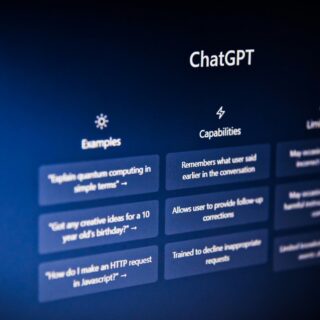

![[On Demand] The AI-Enabled Graduate: Mastering Gen AI's Impact on Early Careers Recruitment](https://www.peoplescout.com/wp-content/uploads/2025/05/AI-enable-applicant-report-320x320.jpg)
